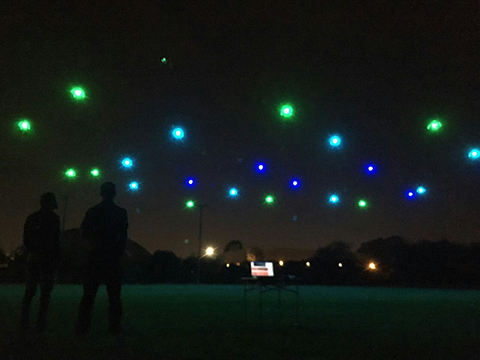Strange sights will fill the night skies over Ontario Place this summer and they won’t be UFOs.
Using technology developed in part at U of T’s aerospace program, a Toronto start-up called Arrowonics has created a way to coordinate and choreograph light-emitting drones so that they create pictures in the sky. For a series of shows this summer at Ontario Place, they’ll be doing displays dedicated to “Canada/Ontario 150.” A loon, a hockey stick and a canoe are among the images you may see. (Weather permitting of course. Drones don’t like wind or rain.)
Founded a little more than two years ago, the company builds on technology originated by Prof. Hugh Liu, head of the Flight Systems and Control lab at U of T, and developed by one his former grad students, Henry Zhu (MASc 2014), now the company’s chief technology officer.
Unlike fireworks, drones are both flashy and environmentally friendly. They don’t cause air pollution and their batteries can be recharged. As with any mechanical device, there’s always the possibility of failure, but the company has built in a number of safety features. GPS-based software keeps the drones synched but safely separate, while their human handlers keep them within a virtual fence, so that the audience is always at a safe distance from any possible mishap.
In the long term, Arrowonics wants to add a design component to the technology so that creative folks can design their own light shows. “That’s our angle,” says Everett Findlay, the company’s chief executive officer and himself an aerospace engineer (MASc 2011). “We want to bring this to the masses and make it as easy as possible to design these shows in a way that really brings out the potential of the technology.” Once a performance is designed, it needs only a couple of people to execute it (including one on laptop-control) and Findlay envisages a time when a performance could be created in Toronto, for example, but downloaded and delivered anywhere in the world.
The strength of the performance is limited only by the designer’s imagination and of course the number of drones. It takes seven to 12 drones just to spell out a letter but with enough drones you could start to tell animated stories. At the moment, Arrowonics can’t deploy more than 110 at a time but they’re tweaking their communications technology to accommodate more.
The basic technology could be used anywhere there’s a need to control multiple drones – in agriculture, for instance, where teams of drones might one day monitor crops, or at crowded transportation hubs where flocks of delivery drones will need to be organized as they come and go. But for the moment, Arrowonics is interested mainly in the entertainment sector, such as theme parks and concerts, with the potential for mind-blowing performances still largely untapped. (In addition to Ontario Place, they’re also performing at the PNE in Vancouver for three weeks this summer.)
“We’re really just at the beginning of this technology,” says Findlay. “It’s not going to be long before we start to see a couple of thousand drones. It’s going to be a full-blown 3D movie in the sky.”







No Responses to “ 3D Movies in the Sky ”
Good use of technology however I'm curious how this differs from the Intel technology?
see: https://www.intel.com/content/www/us/en/technology-innovation/aerial-technology-light-show.html